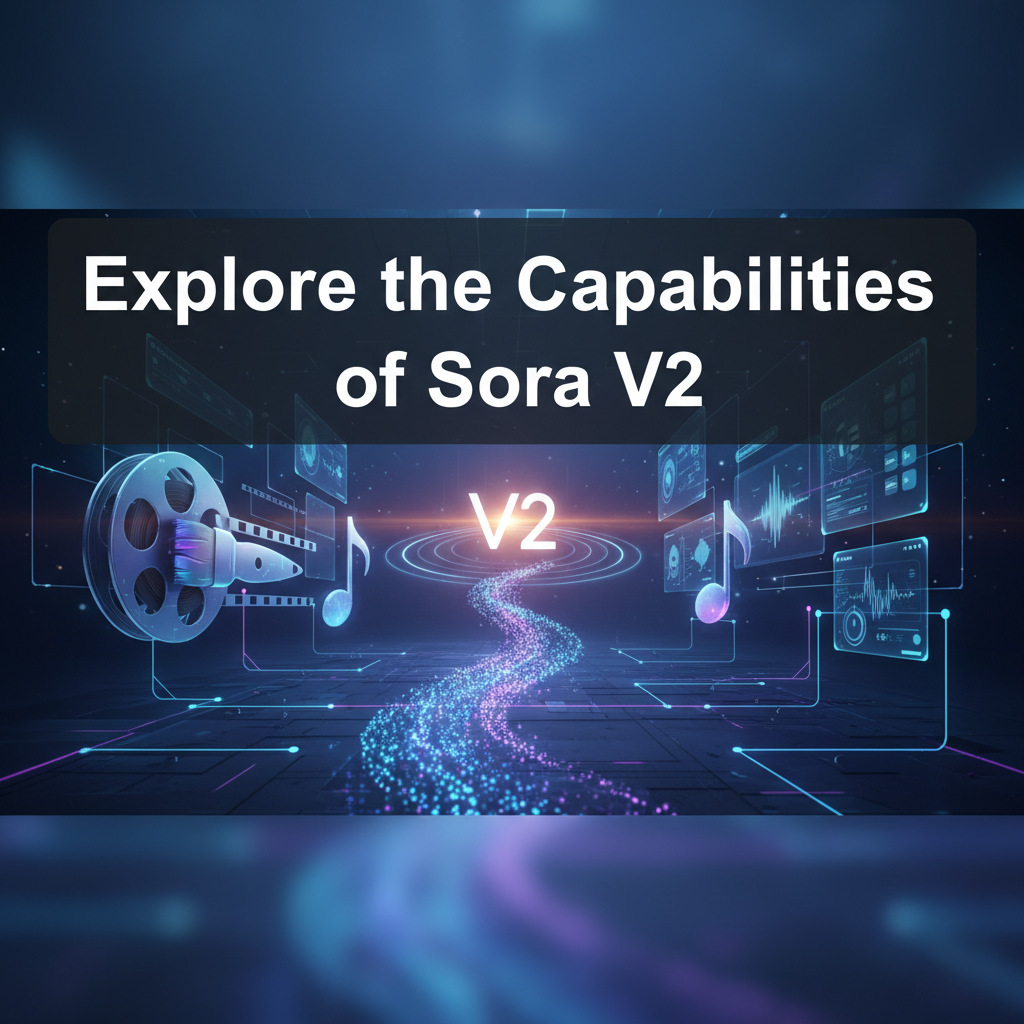Explore the Capabilities of Sora V2
Estimated reading time: 5 minutes
- Advanced video and audio generation with synchronized elements
- Ultra-high 4K resolution and 90-second video capabilities
- Enhanced physics simulation for realistic movements
- Cinematic grammar features for better storytelling
- Accessible pricing with free tier options
Table of Contents
- Core Capabilities
- Video and Audio Generation
- Motion and Physics
- Consistency and Continuity
- Cinematic Features
- Access and Pricing
- Comparison with Predecessors
- Conclusion
- FAQ
Core Capabilities
Video and Audio Generation
One of the flagship features of Sora V2 is its ability to generate video content with synchronized audio. This innovation eliminates the need for separate audio synthesis, streamlining the video creation process for users. You can produce videos that not only look stunning but also sound coherent, striking a perfect balance between visual and audio elements (source: Cursor IDE).
Sora V2 supports ultra-high 4K resolution video outputs, catering to the demands of modern media consumption where high-quality visuals are paramount. The capability to create videos up to 90 seconds long opens up new avenues for storytelling and engagement, allowing creators to delve deeper into narrative arcs than previously possible with Sora V1, which maxed out at 60 seconds of 1080p resolution (source: Cursor IDE).
Additionally, the advancements in physics simulation within Sora V2 are noteworthy. This version addresses previous limitations regarding gravity and collision detection, leading to more realistic interactions in generated scenes (source: HiggsField).
Motion and Physics
Sora V2 excels in advanced physics modeling, accurately simulating complex movements that can range from the intricacy of Olympic gymnastics to the nuanced buoyancy of paddleboarding. This level of detail ensures that the generated content resonates with viewers in an authentic manner (source: HiggsField).
The technology tracks 87 human joint parameters to provide realistic body physics. This prevents common issues observed in video generation, such as “broken limbs” or “floating characters.” Ensuring natural motion is a critical improvement, making character animations appear fluid and believable (source: HiggsField).
Consistency and Continuity
Maintaining visual fidelity over time is essential for any storytelling endeavor. Sora V2’s object permanence feature ensures that elements remain consistent across frames, which significantly reduces visual glitches that can break immersion (source: HiggsField).
Furthermore, the model exhibits multi-shot consistency. This means that characters and scenes can seamlessly carry over between multiple takes, enabling filmmakers to craft more intricate narratives without the fear of jarring visual discrepancies (source: Cursor IDE).
Cinematic Features
Sora V2 embodies a nuanced understanding of cinematic grammar, comprehending key aspects like camera movements, framing, and shot composition. This allows creators to exert more control over their videos while achieving a realistic portrayal of cinematographic techniques (source: Cursor IDE).
Another interesting addition is the cameo feature, which allows users to integrate real-world elements by simply capturing a quick video and audio snippet. This capability is particularly beneficial for creating personalized digital avatars, enabling a unique and customized viewer experience (source: HiggsField; source: Skywork).
Access and Pricing
For those interested in harnessing the capabilities of Sora V2, accessibility has been thoughtfully designed. Users can access the technology via a free tier available at sora.com, which includes usage limits that cater to casual users and hobbyists. For those seeking more extensive capabilities, subscription options are available through ChatGPT Plus and Pro (source: Cursor IDE).
The official Sora V2 API is currently undergoing private beta testing, with an anticipated release that is sure to excite developers and creators keen on incorporating AI-driven video generation into their projects (source: Cursor IDE).
Comparison with Predecessors
When pitting Sora V2 against its predecessor, Sora V1, the advancements are undeniable. Not only does Sora V2 provide 4K+ resolution compared to the 1080p limit of the original model, but it also increases the video duration capability to 90 seconds (source: Cursor IDE).
The introduction of synchronized audio generation marks a pivotal upgrade, as Sora V1 did not offer this feature, catering instead to the rudimentary audio formats that can often detract from the overall experience (source: Cursor IDE).
Conclusion
As we have explored the capabilities of Sora V2, it’s evident that this innovative technology is set to reshape the landscape of video generation. By offering enhanced features such as synchronized audio, realistic physics, and advanced cinematic techniques, Sora V2 provides creators with a comprehensive toolkit for crafting compelling narratives and visuals.
Whether you’re a filmmaker, content creator, or developer, the advancements in Sora V2 position it as an essential asset for anyone looking to leverage AI in their video production processes. As technology continues to evolve, Sora V2 stands at the forefront, driving the future of storytelling through the power of AI.
For more trending news, visit NotAIWorld.com.
FAQ
Q: What is Sora V2?
A: Sora V2 is OpenAI’s advanced video generation technology that offers synchronized audio, high-resolution video output, and realistic physics simulations.
Q: How does Sora V2 compare to Sora V1?
A: Sora V2 supports 4K resolution, longer video durations, and introduces synchronized audio, unlike its predecessor Sora V1.
Q: Where can I access Sora V2?
A: Users can access a free tier of Sora V2 at sora.com, with additional subscription options through ChatGPT Plus and Pro.
Q: What are the key features of Sora V2?
A: Key features include synchronized audio generation, advanced physics modeling, and capabilities for generating longer, high-resolution videos.
